![]()
![]()
![]()
Use LEFT and RIGHT arrow keys to navigate between flashcards;
Use UP and DOWN arrow keys to flip the card;
H to show hint;
A reads text to speech;
47 Cards in this Set
- Front
- Back
|
Parts of the Sperm |
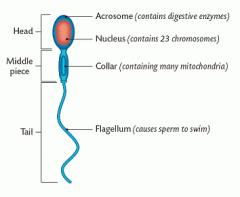
|
|
|
How to ensure same species |
-Contact and recognition between sperm and egg -Chemotaxis -Acrosomal Rxn -Glycoproteins outisde of zona pellucida (ZP1 ,ZP2, ZP3) |
|
|
General Over-view of Fertilization |
-Contact and recognition between sperm and egg -Regulation of sperm entry into the egg -Fusion of genetic material -Activation of egg metabolism to start development |
|
|
Parts of the sperm |
-Haploid nucleus -Propulsion system -nucleus becomes streamlined and DNA becomes tightly compressed -acrosome |
|
|
acrosome |
-derived from golgi apparatus -contains enzymes that digest proteins and complex sugars ***digest outer layer of egg |
|
|
Capacitation |
-Final maturation of the sperm -Happens inside female reproduction tract |
|
|
Oocyte |
the developing egg -cytoplasmic storehouse |
|
|
Recognition of Sperm and Egg |
1) Chemoattraction of the sperm to the egg by soluble molecules secreted by the egg 2) Exocytosis of the sperm acrosomal vesicle and release of its enzyme 3)Binding of the sperm to the extracellular matrix (vitelline envelope, or zona pellucida) of the egg 4)Passage of the sperm through extracellular matrix 5)Fusion of the egg and sperm cell membranes
|
|
|
Zona Pellucida |
-Extracellular envelope of mammalian eggs |
|
|
Chemotaxis |
-Sperm attracted to egg of the species by chemical gradient |
|
|
Acrosome Reaction |
-Fusion of acrosomal vesicle with sperm cell membrane and extension of acrosomal process
-Serves as a barrier to interspecies fertilization because polysacharides are species specific |
|
|
One egg One Sperm |
-Haploid sperm+haploid egg= diploid nucleus
ZYGOTE!
-Monospermy
|
|
|
Fast Block of Polyspermy |
-Initial fast rxn by electric charge in egg (cell membrane)
-This prohibits entry of Na+ ions into the egg(changes resting potential from negative to positive **no more sperm can fuse to the egg**
-Followed by exocytosis of the cortical granules |
|
|
Slow Block Polyspermy |
Cortical Granule RXN
|
|
|
Cortical Granule RXN |
-mechanical block to polyspermy that becomes active a minute after successful sperm-egg fusion
-enzymes from egg's cortical granule contribute to the formation of a fertilization envelope that blocks further sperm entry
-enzyme cleaves the protein posts that connect the zona pellucida proteins to the egg cell membrane
|
|
|
Mechanism of Cortical Granule Exocytosis is:
-Also is similar to which: |
-Ca2+ in egg cytoplasm increases greatly upon fertilization causing the cortical granules to fuse with egg cell (stored in the ER of the egg)
-Similar to acrosome exocytosis |
|
|
Ca2+ Release |
-Initiating cortical granule exocytosis
-Critical for activating egg's metabolism and initiating development (allowing mRNA to translate, release inhibition of nuclear divison- allowing cleavage to occur) |
|
|
The two major events to get gamete into Oviduct |
1)Translocation
2)Capacitation |
|
|
Ampulla |
-The region of oviduct where fertilization takes place |
|
|
Translocation
Female |
Female: -Mammalian oocyte released from ovary is surrounded by cumulus cells which allows the oocyte to travel into the oviducts
-Cumulus oocyte complex is moved to appropriate site of fertilization |
|
|
Translocation : , Male |
Sperm are transported to the oviduct by muscular activity in the uterus
1)Uterine muscles contract- sperm to oviduct
2)Region before ampulla slow down sperm
3)Sperm flagellar motility becomes important -once sperm is in oviduct they becomes hyperactive!
4)Sperm may receive directional cues from temp. gradients and chemical gradients from oocyte or cumulus
5)During trek from vagina to ampullary region of the oviduct-sperm matures so it can fertilize the egg (Capacitation) |
|
|
Basic Capacitation |
-Set of physiological changes by which sperm becomes capable of fertilizing an egg
-molecular process: prepare sperm for acrosome rxn, enable motility of sperm to become hyperactive
-Sperm that are not capacitated are held up in cumulus matrix
|
|
|
Steps of Capacitation |
1)Sperm cell membrane altered-now contain proteins that can bind to zona pellucida and participate in acrosome rxn
2)Some carbs and proteins on surface are lost
3)Potassium leaves sperm- more negative, Ca2+ comes in = raises the pH
4)Protein phosphorylation occurs- Chaperone proteins migrate to surface (IZUMO)
5)Acrosomal membrane changes and comes into contact with cell membrane
|
|
|
Hyperactivation |
-allows sperm to detach from oviduct epithileal tissues
-Heat helps direct sperm- chemotaxis in ampullary region |
|
|
Acrosome RXN and recognition at Zona Pellucida |
-Before binding to oocyte sperm must bind to and penetrate zona pellucida
-glycoproteins ZP1, ZP2, ZP3 |
|
|
Detailed slow block polyspermy in Mammals |
-enzymes released by the cortical granules modify the zona pellucida sperm receptor proteins-no longer bind to sperm
-Zp2 is clipped
|
|
|
Transient rise in cytoplasmic Ca2+ is necessary for egg activation - sperm induces it |
1)Resumption of meiosis 2)Cortical granule exocytosis 3)Release of inhibition on maternal mrnas 4)Formation of male and female pronucleus |
|
|
Gametogenesis |
-production of sperm (spermatogensis) in the testies and oocyte (oogenesis) in the ovaries
-OOgenesis begins at puberty and ends at metapause
-Sperm is produced in the seminiferous tubules
|
|
|
Anatomical Features of the Egg |
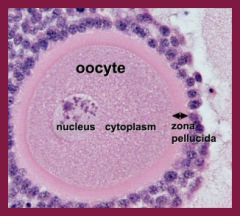
|
|
|
Parts of the the female reproductive tract |
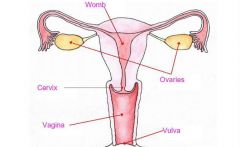
|
|
|
Primary Follicle |
-Only the primary follicle that receives the most FSH continues to secondary follicle
-The rest die - CORPUS LUTEUM
-OOcyte travels from ovary to fallopian tubes |
|
|
Follicle Development |
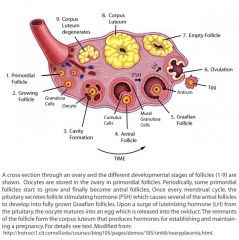
|
|
|
Compare and Contrast Oogenesis and Spermatogenesis |
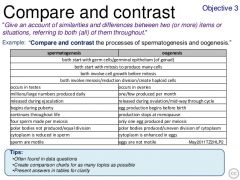
|
|
|
Follicle Development |
-Primordial follicle, secondary follicle, mature follicle, cumulus cell (oocyte), empty follicle, corupus luteum, degenerating corpus luteum |
|
|
Hormonal Control of Ovulation |

|
|
|
Delivery Hormones |
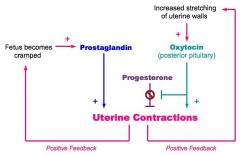
|
|
|
Delivery Hormones |
Estrogen from ovaries induces oxytocin receptors on uterus
-Uterin muscles contract and baby's head is pressed against the cervix -signals the brain to release more oxytocin
**oxytocin (from mother and fetus) and prostaglandis (from fetus) ** both positive feed back loops |
|
|
Concepts of IVF |
IVF- removal of eggs from the ovary -they are fertilized in the laboratory -subsequent placement of the resulting embryos in the uterus
1)ovary stimulated 2)egg retrieved 3)fertilization in a dish and cells divide in vitro 4)embryo transferred into uterus |
|
|
Concepts of PGD - Pre-Implantation Genetic Diagnosis |
-used with IVF to test for genetic issues
1)Super ovulation 2)IVF 3)Embryo bopsy- genetic testing 4)Genotype of embryo is inferred from test only non-mutant embryos are transferred
|
|
|
Maturation Process of Sperm |
Translocation: SPERM travels through vagina into cervix, uterus, and fallopian tubes - fertilization happens in ampulla region
-involves THERMOTAXIS
-CHEMOTAXIS
CAPACITATION: sperm maturation the set of physiological changes by which sperm become competent to fertilize the egg |
|
|
Capacitation |
-Surface proteins and intracellular transduction pathways change during sperm maturation
1)insemination 2)initial capacitation 3)creation of a transient sperm reservoir in the isthmic region of the oviduct 4)Hyperactivation 5)Sperm penetration of the cumulus mass 6)Zona pellucida penetration
|
|
|
Diagram of Sperm binding to zona |
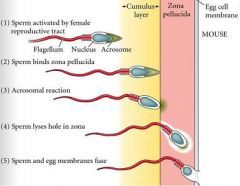
|
|
|
OOcyte Activation |
1)SPerm motility and chemotaxis 2)Acrosome rxn 3)PLCy injected into the oocyte 4)Cytosolic calcium oscillator 5)Ca2+ oscillations 6)OOcyte activation- cell proliferates/male nucleus enters the cell |
|
|
Prevention of Polyspermy |
Fast Block! - electric charge in the egg membrane
-sperm can only fuse with egg membrane potential is negative NOT POSITIVE
|
|
|
How does membrane fusion begin |
-Sperm tip makes contact with egg adn the acrosome rxn occurs
-expelling enzymatic contents of acrosome -express the inner acrosomal membrane to the outside (EQUITORIAL REGION: junction between inner acrosomal membrane and sperm cell membrane) |
|
|
SLOW BLOCK |
Cortical Granule Rxn
-exocytosis of cortical granules
-results in cleavage of SP2
-figure 4.19 |
|
|
RECAP! |
Fertilization- combining 2 sets of genes and creation of new organism -contact between sperm and egg -fusion of genetic material from 2 gametes -deactivation of egg metabolism to start development
-both egg and sperm are active, and both involve Ca2+ ions and membrane fusion
-Slow Block- Cortical granule rxn
-fusion of sperm and egg results in activation of metabolic rxn- reinitiating of egg into cell cycle and mitoic divisions - resumption of DNA and protein synthesis |

